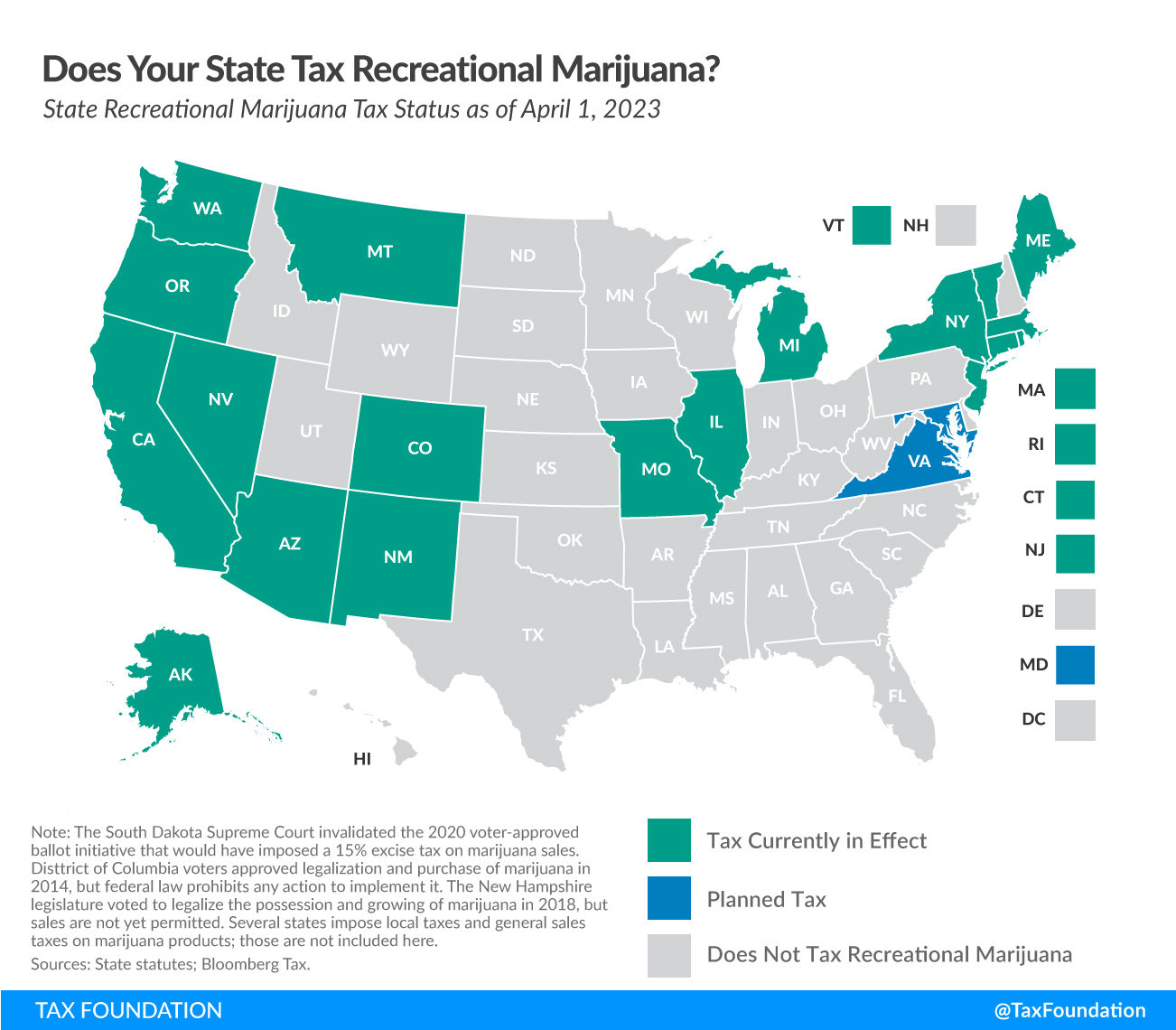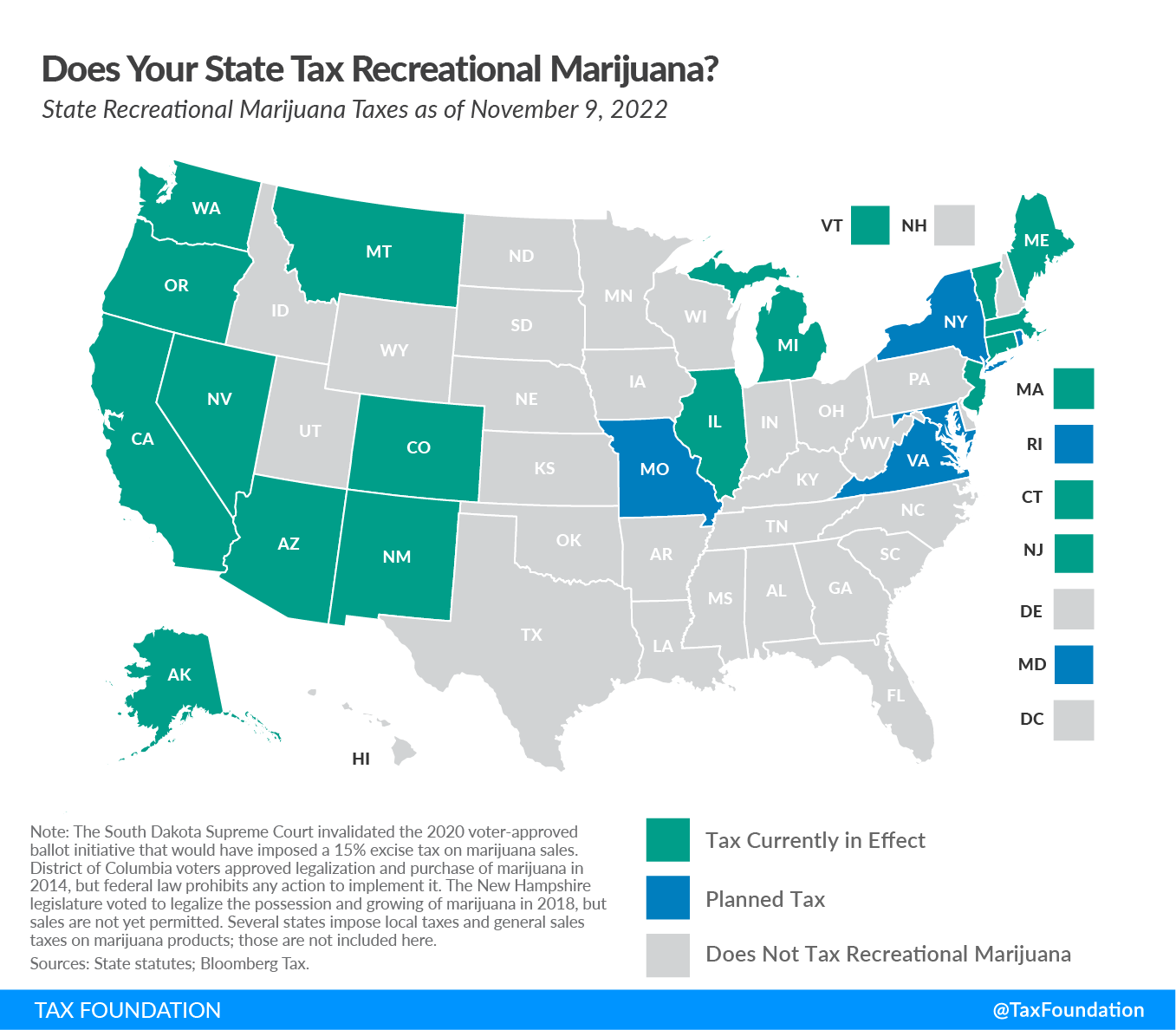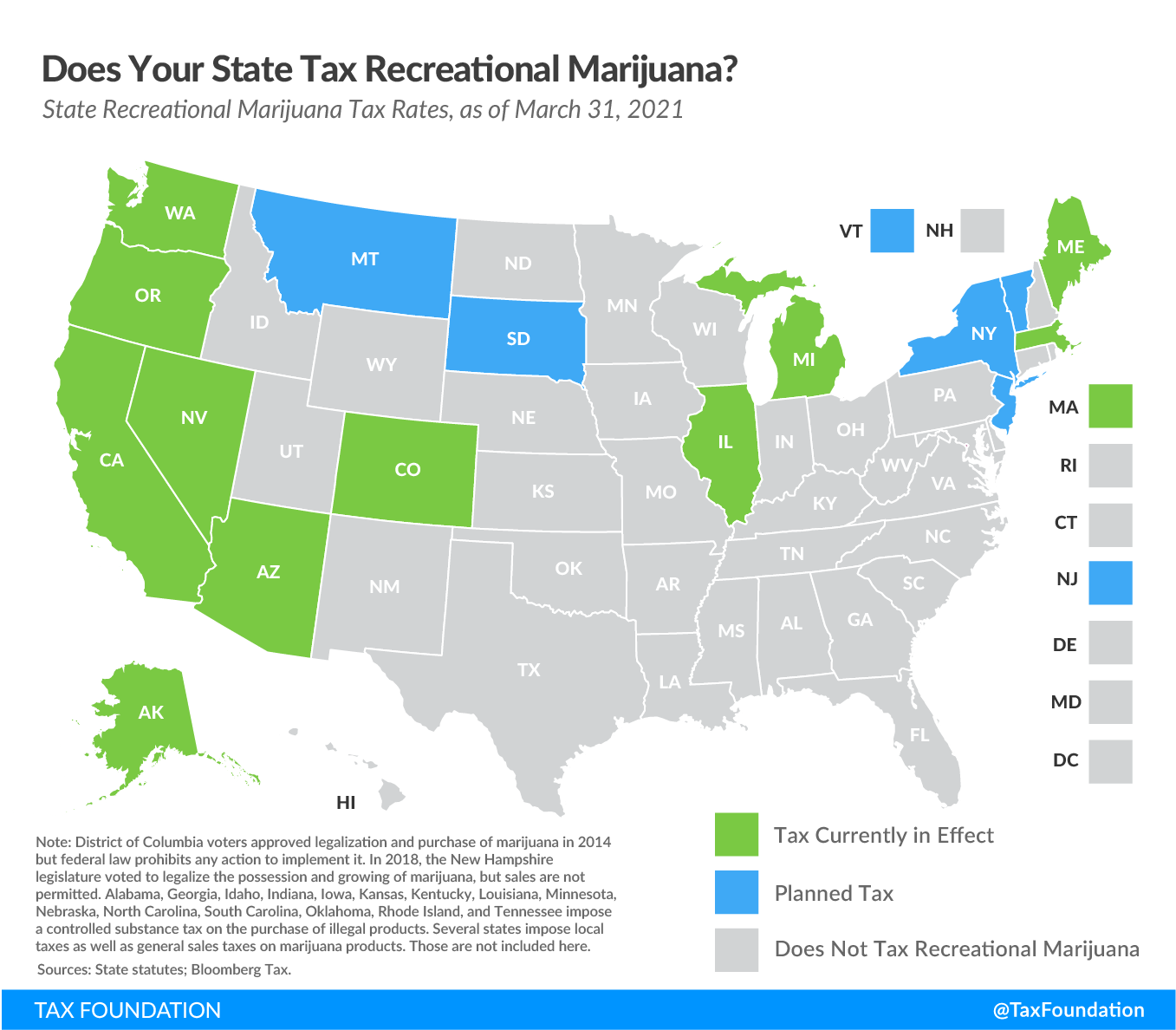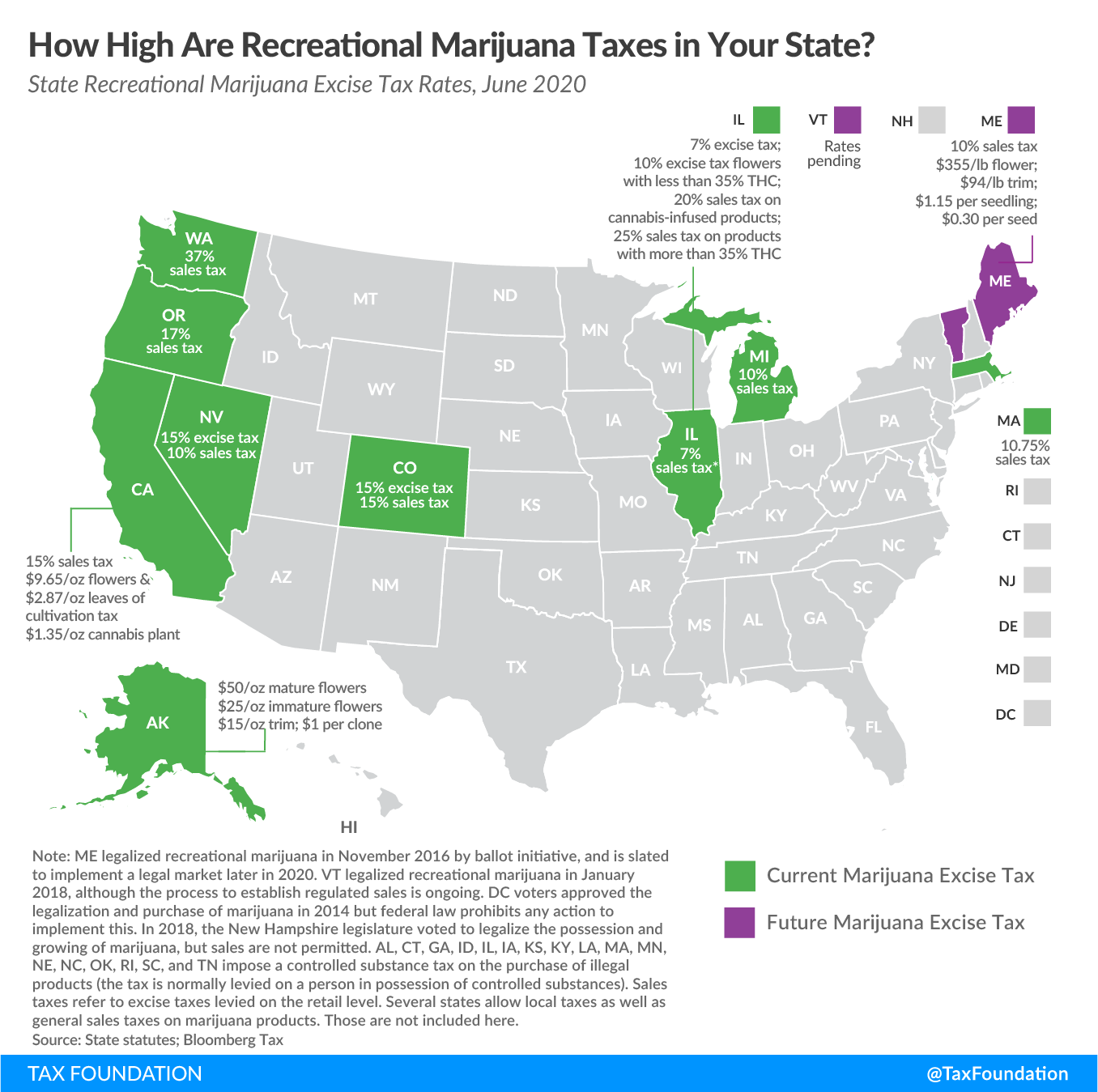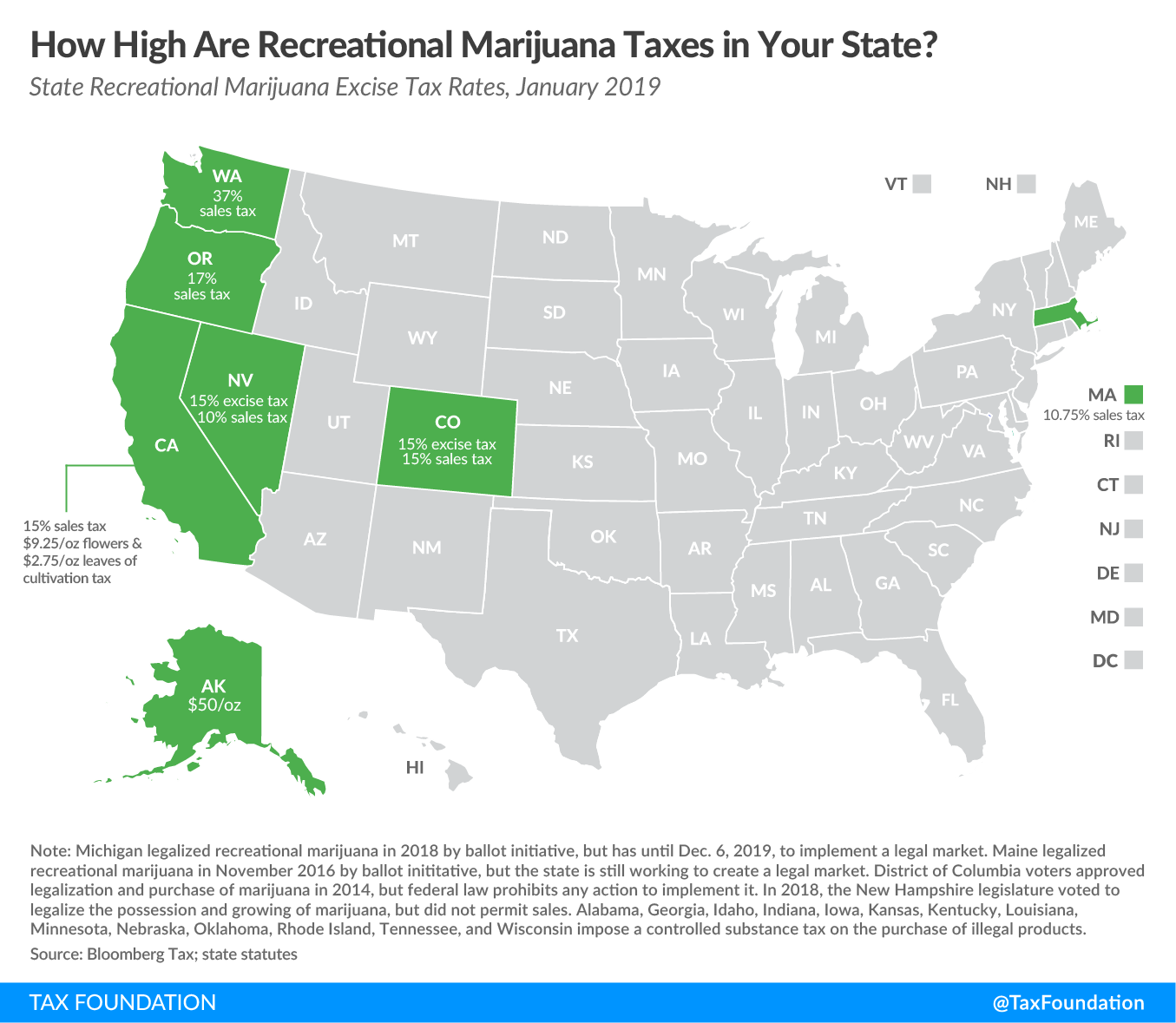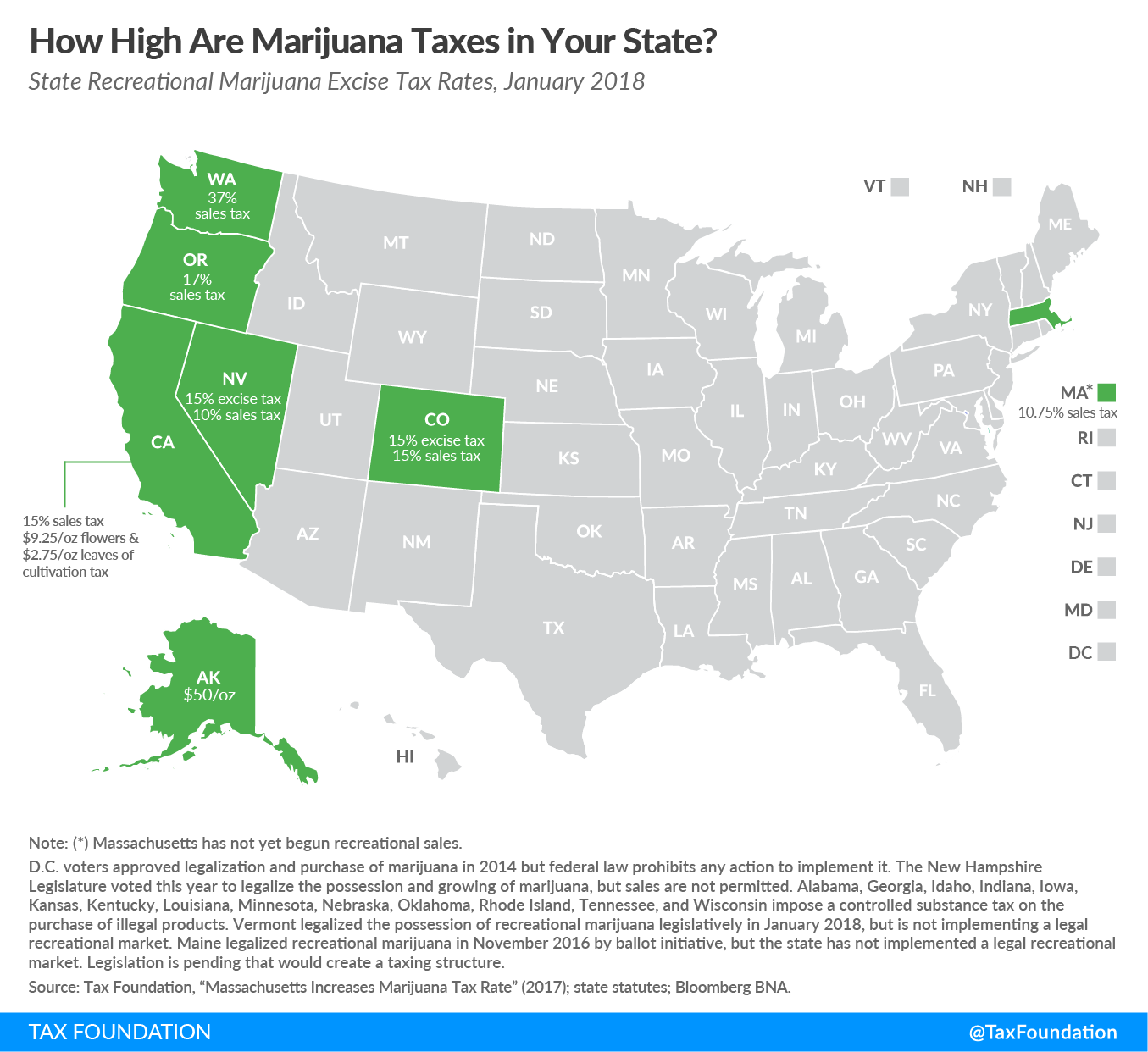Recreational marijuana taxation is one of the hottest policy issues in the US. Many states have elected to regulate and taxA tax is a mandatory payment or charge collected by local, state, and national governments from individuals or businesses to cover the costs of general government services, goods, and activities. legal marijuana sales and consumption, despite the ongoing federal prohibition. This week’s map shows states that have established a legal recreational cannabis market subject to an excise taxAn excise tax is a tax imposed on a specific good or activity. Excise taxes are commonly levied on cigarettes, alcoholic beverages, soda, gasoline, insurance premiums, amusement activities, and betting, and typically make up a relatively small and volatile portion of state and local and, to a lesser extent, federal tax collections. . Legalization shifts consumers to safer legal markets while generating tax revenue for state programs. Harms associated with recreational marijuana are still somewhat understudied, but as more states allow legal markets, more information will be available to optimize tax design.
Approaches to tax structure vary significantly across states. Some states tax by weight, some by price, and others by THC content. Ad valorem taxes are simpler but are associated with greater revenue volatility and do not target any specific harm-causing element. Ad quantum taxes on weight or quantity produce more stable revenues and better target the harm-causing element, but do not account for potency. Ad quantum taxes based on THC content most directly target the harm-causing element, but this adds complexity to the tax and the technology to measure THC content is often too expensive to make this option viable yet.
Disparate structures render state-by-state comparisons of rates or overall tax burden difficult. With federal prohibition still in effect, interstate commerce remains illegal, which creates a siloed market within each legalized state. Possible federal legalization or descheduling of marijuana may encourage harmony between state systems. When states legalize marijuana, taxes on legal product should be low enough to allow legal markets to compete with illicit markets, thereby reducing individual and societal harm while generating more revenues.
2025 Recreational Marijuana Taxes by State
State Excise Tax Rates on Recreational Marijuana, as of January 2025
| State | Tax Rate |
|---|---|
| Alaska | $50/oz. mature flowers; $25/oz. immature flowers; $15/oz. trim; $1 per clone |
| Arizona | 16% on Retail Sales |
| California (a) | 15% on Retail Gross Receipts |
| Colorado | 15% on Wholesale Average Market Rate ($658 per Pound of Bud); 15% on Retail Sales |
| Connecticut | 3% on Retail Sales; $0.00625 per milligram of THC in plants; $0.0275 per milligram of THC in edibles; $0.009 per milligram of THC in other cannabis products; $1 per THC Infused Beverage |
| Delaware (b) | 15% on Retail Sales |
| Illinois | 7% on Wholesale Gross Receipts; 10% on Retail Sales of cannabis products with ≤35% THC; 20% on Retail Sales of cannabis-infused products like edibles; 25% on Retail Sales of any product with a THC concentration >35% |
| Maine | 10% on Retail Sales; $335/lb. flower; $94/lb. trim; $35 per mature plant; $1.5 per immature plant or seedling; $0.30 per seed |
| Maryland | 9% on Retail Sales |
| Massachusetts | 10.75% on Retail Sales |
| Michigan | 10% on Retail Sales |
| Minnesota (b) | 10% on Retail Gross Receipts |
| Missouri | 6% on Retail Sales |
| Montana | 20% on Retail Sales |
| Nevada | 15% on Wholesale Fair Market Value ($1,296 per Pound of Flower); 10% on Retail Sales |
| New Jersey | $2.50 per ounce |
| New Mexico (a) | 12% on Retail Sales |
| New York | 9% on Wholesale Sales; 13% on Retail Sales |
| Ohio | 10% on Retail Sales |
| Oregon | 17% on Retail Sales |
| Rhode Island | 13% on Retail Sales |
| Vermont | 14% on Retail Sales |
| Washington | 37% on Retail Sales |
(a) Rate scheduled to increase July 1, 2025
(b) Actual retail sales not yet begun as of January 2025
Source: State Statutes; Bloomberg Tax
Data compiled by Adam Hoffer, Jacob Macumber-Rosin
State Excise Tax Rates on Recreational Marijuana, as of September 2024
| State | Tax Rate(s) | Notes |
|---|---|---|
| Alaska | $50/oz of Mature Flowers | |
| Alaska | $25/oz of Immature Flowers and Abnormal Buds | |
| Alaska | $15/oz of Plant Trims | |
| Alaska | $1 per Clone Plant | |
| Arizona | 16% on Retail Sales | If a federal excise tax is imposed, AZ caps combined rates to 30% and automatically reduces the state rate to combine to 30%. |
| California | 15% on Retail Gross Receipts | Counties may impose additional excise taxes, which would be included in the gross receipts for the purposes of the state excise tax. |
| Colorado | 15% on Wholesale Average Market Rate | Counties and municipalities can impose additional excise taxes on wholesale transactions, up to 5%. |
| Colorado | 15% on Retail Sales | |
| Connecticut | $0.00625 per milligram of THC in plant material | |
| Connecticut | $0.0275 per milligram of THC in edible products | |
| Connecticut | $0.009 per milligram of THC in other cannabis | |
| Connecticut | $1 per THC Infused Beverage | |
| Connecticut | 3% Municipal Tax on Retail Gross Receipts | |
| Delaware | 15% on Retail Sales | The tax was imposed in April 2023, but sales have yet to actually begin. The Office of the Marijuana Commissioner only began accepting applications for licenses in August 2024. Licenses for cultivation are expected to be issued in November 2024, product manufacturing in December 2024, and retail in March 2025. |
| Illinois | 7% on Wholesale Gross Receipts | Counties and municipalities may impose additional taxes up to 3.75%. |
| Illinois | 10% on Retail Sales of Products with 35% or less THC | |
| Illinois | 20% on Retail Sales of Cannabis-Infused Products | |
| Illinois | 25% on Retail Sales of Products with more than 35% THC | |
| Maine | $335/lb of Flowers | |
| Maine | $94/lb of Plant Trim | |
| Maine | $35 per Mature Plant | |
| Maine | $1.5 per Immature Plant or Seedling | |
| Maine | $0.3 per Seed | |
| Maine | 10% on Retail Sales | |
| Maryland | 9% on Retail Sales | |
| Massachusetts | 10.75% on Retail Sales | Localities may impose additional taxes up to 3%. |
| Michigan | 10% on Retail Sales | |
| Minnesota | 10% on Retail Gross Receipts | |
| Missouri | 6% on Retail Sales | Cities and counties may impose additional taxes up to 3%, which was interpreted by Missouri courts to mean 3% each to total 6%. |
| Montana | 20% on Retail Sales | Counties may impose additional taxes up to 3%. |
| Nevada | 15% on Wholesale Fair Market Value | |
| Nevada | 10% on Retail Sales | |
| New Jersey | $1.24/oz Social Equity Excise Fee | The Social Equity Excise Fee is calculated to be 0.333% of the Average Retail Price, capped per ounce depending on the Average Retail Price up to $10/oz. The rate cap increases if the average retail price decreases. Municipalities may impose additional taxes, up to 1% on wholesale receipts or 2% on cultivator, manufacturer, and retailer receipts, totaling 7% before accounting for pyramiding effects. |
| New Mexico | 12% on Retail Sales | Beginning July 1 2025, the tax is set to increase incrementally 1% per year until reaching 18% in July 2030. |
| New York | 9% on Wholesale Sales | |
| New York | 9% on Retail Sales | |
| New York | 4% Local Tax on Retail Sales | |
| Ohio | 10% on Retail Sales | Legal retail sales began August 2024. |
| Oregon | 17% on Retail Sales | Cities and counties may impose additional taxes up to 3%. |
| Rhode Island | 10% on Retail Sales | |
| Rhode Island | 3% Local Tax on Retail Sales | |
| Vermont | 14% on Retail Sales | |
| Washington | 37% on Retail Sales |
Sources: State Statutes; Bloomberg Tax.
2024 Notable Changes
- Minnesota legalized recreational marijuana and taxes sales at 10 percent of retail gross receipts.
- Ohio legalized recreational marijuana and taxes sales at 10 percent of retail sales.
- Delaware established a 15 percent tax on retail sales, but business licensure has yet to be completed, so sales have yet to begin. Retail licenses are expected in March 2025.
- California switched its wholesale-level tax to a tax levied on retail gross receipts.
- New York swapped its specific tax by THC content for a 9 percent ad valorem wholesale tax.
- Planned legalization in Virginia was not authorized by the state legislature, and a subsequent attempt to legalize recreational sales and tax them at 11.625 percent was vetoed by the governor.
Data compiled by Adam Hoffer, Jacob Macumber-Rosin
2025 Notable Changes
- New Jersey has increased the Social Equity Excise Fee on marijuana sales from $1.24 per ounce to $2.50 per ounce.
- The Virginia legislature passed a bill legalizing recreational sales and taxing them at 8 percent of retail sales and providing for a 2.5 percent local option tax, but the bill was vetoed by the Governor.
Nearly half of US states regulate and tax recreational marijuana markets, and all but 11 states have allowed medical marijuana. A few states have decriminalized possession but have not allowed cultivation or sale of marijuana, sometimes due to vetoes or court rulings blocking legalization. Many states that have not yet legalized marijuana seem to be moving toward legalization, but challenges clearly remain. Efforts to reform federal policy have been unsuccessful thus far, but new attempts have experienced increased support.
Several states, often those facing budget shortfalls, are considering increases to marijuana excise tax rates, while other states are considering decreasing their marijuana tax rates. Gubernatorial budget proposals in Maine, Maryland, Michigan, New Jersey, and Ohio included significant increases to marijuana taxes, and the Oregon legislature is considering increasing the cap on local taxes. Elsewhere, Alaska SB 73 would decrease the state’s tax from $50 per ounce to $12 per ounce, Nevada AB 307 would abolish the 15 percent wholesale tax while raising the retail tax from 10 percent to 14.25 percent, and California and New Mexico legislatures are considering abolishing the scheduled statutory increases to their marijuana taxes.
In several states, like Virginia and New Hampshire, enough support in the legislature exists to pass legalization bills but not enough to overcome gubernatorial vetoes. In other states, like Pennsylvania and Wisconsin, supportive governors have requested legalization bills from the legislature, but legislatures have declined to act. States like South Dakota and Florida have had majorities of voters support legalization ballot initiatives, but state courts or constitutional supermajority requirements have prevented those efforts to date.
Some states that have already legalized marijuana, like Ohio and Montana, have had their legislatures and/or governors attempt to recriminalize marijuana, in some cases after the adoption of voter approved ballot initiatives. In Texas, several municipalities have skirted federal and state prohibitions to legalize marijuana with voter initiatives, but Texas SB 1870 is under consideration in the state legislature to ban municipalities from legalization through those means—even in home rule jurisdictions. Idaho’s legislature recently passed HJR 4, which puts a constitutional amendment up for consideration of the voters in 2026 that would prohibit voter initiatives from legalizing marijuana or other drugs.
At the federal level, recent discussions of formally rescheduling marijuana from Schedule I to Schedule III may have tax implications and would make it easier for prohibition states to legalize marijuana. Other proposed reforms like the STATES 2.0 Act would defederalize marijuana policy entirely, removing cannabis from the Controlled Substances Act and allowing for interstate commerce between states that have legalized marijuana within their jurisdictions.
Under the existing federal prohibition, businesses that operate in states that disregard federal policy to establish “legal” markets remain burdened by the inability to participate in interstate commerce. These businesses also have difficulty doing business with banking institutions and face struggles associated with the unique legal framework.
Even as some states legalize sales, a significant majority of marijuana consumption occurs via illicit markets. States that impose excessive taxes, require expensive or limited licensure, or otherwise hinder their legal markets may not experience significant reductions in illicit consumption. If prices in legal markets are kept higher than illicit market prices, consumers will not be incentivized to switch to safer legal products. Taxes on legalized marijuana should not be so burdensome as to preclude legal markets from effectively competing with illicit markets. Properly designed taxes have the potential to generate billions of dollars in revenue for the states, though it may take some time for these revenues to be realized as legal markets are developed.
With interstate commerce prohibited, the disparate tax designs across states do not yet create some of the problems that occur in other legal markets. There are no multistate businesses that must comply with varied regulations, and tax arbitrage or double taxationDouble taxation is when taxes are paid twice on the same dollar of income, regardless of whether that’s corporate or individual income. cannot legally occur. However, if interstate commerce is eventually tolerated by the federal government, the significant differences in tax designs may create negative effects and opportunities for tax avoidance. States should prepare to harmonize their tax designs once interstate marijuana business is allowed—and would be better advised to coalesce around best practices now, before systems become more difficult to reform.
Stay informed on the tax policies impacting you.
Subscribe to get insights from our trusted experts delivered straight to your inbox.
Subscribe